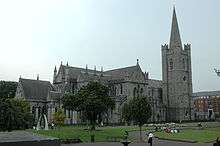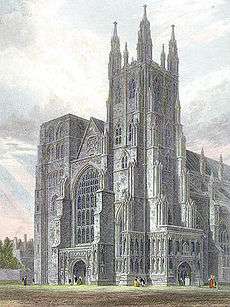Church of Ireland
| Church of Ireland Eaglais na hÉireann[1] Kirk o Airlann[2] | |
|---|---|
|
| |
| Founder |
Claims episcopal succession from Saint Patrick.[3] Established as a state church in 1536 under King Henry VIII of England. Disestablished in 1871 under Queen Victoria. |
| Independence | 1871 (disestablishment) |
| Primate |
Richard Clarke, Archbishop of Armagh |
| Polity | Episcopal |
| Headquarters |
Church of Ireland House Church Avenue, Rathmines Dublin 6 D06 CF67 Republic of Ireland |
| Territory | Ireland |
| Language | English, Irish |
| Members | 410,000 members[4] |
| Website | ireland.anglican.org |
| Part of a series on |
| Anglicanism |
|---|
| Theology |
| Ministry and worship |
| Christianity |
| Background and history |
| Anglican Communion |
| Continuing Anglicanism |
|
|
The Church of Ireland (Irish: Eaglais na hÉireann Scots: Kirk o Airlann) is a Christian church in Ireland and an autonomous province of the Anglican Communion. It is organised on an all-Ireland basis and is the second-largest Christian church on the island after the Roman Catholic Church. Like other Anglican churches, it has retained elements of pre-Reformation practice, notably its episcopal polity, while rejecting the primacy of the Bishop of Rome. Nevertheless, in theological and liturgical matters, it incorporates many principles of the Reformation, particularly those espoused during the English Reformation. The church self identifies as being both Catholic and Reformed.[5] Within the church, differences exist between those members who are more Catholic-leaning (high church) and those who are more Protestant-leaning (low church or evangelical).[6] For historical and cultural reasons, the Church of Ireland is generally identified as a Protestant church.[7] The Church of Ireland is the second-largest in the Republic of Ireland, with around 130,000 members,[8] and the third-largest in Northern Ireland, with around 260,000 members.[9]
Overview
The Church of Ireland describes itself as
that part of the Irish Church which was influenced by the Reformation, and has its origins in the early Celtic Church of St Patrick.[10]
The Church of Ireland considers itself Catholic because it is in possession of a continuous tradition of faith and practice, based on scripture and early traditions, enshrined in the Catholic creeds, together with the sacraments and apostolic ministry.[11] However, the Church of Ireland is also Protestant, or Reformed, since it opposes doctrines and ways of worshiping that it considers contrary to scripture and which led to the Reformation.
The Church of Ireland, as a Reformed and Protestant Church, doth hereby re-affirm its constant witness against all those innovations in doctrine and worship whereby the Primitive faith hath been from time to time defaced or overlaid, and which at the Reformation this Church did disown and reject.[12]
When the Church of England broke communion with the Holy See, all but two of the bishops of the church in Ireland followed the Church of England, although almost no other clergy did so. The church then became the established church of Ireland, assuming possession of most church property (and so retaining a great repository of religious architecture and other items, though some were later destroyed). The church explains its possession of so many of the ancient church buildings of Ireland by reference to the precedent set by Emperor Constantine the Great in the 4th century:
Since the days of the Emperor Constantine in the 4th century European states saw themselves as having a central role in the government of the Church. This church-state link was vigorously applied when the Normans came to Ireland in the 12th century. Bishops were required to do homage to the king for their lands, just like earls and barons, who were vassals of the crown. It was therefore accepted, both during and after the Reformation, that the crown should continue to exercise that authority over the church, in which it continued to play a central role. In this way, church property that existed at the time of the Reformation, buildings included, was retained by the reformed, established (state) Church of Ireland.
In Ireland, the substantial majority of the population continued to adhere to Roman Catholicism, despite the political and economic advantages of membership in the state church. Despite its numerical minority, however, the Church of Ireland remained the official state church until it was disestablished on 1 January 1871 under Queen Victoria by her Liberal government led by William Ewart Gladstone.
It is the contention of the Church of Ireland that in breaking with Rome, the reformed established church was reverting to a condition that had obtained in the church in Ireland prior to the 12th century — the independent character of Celtic Christianity.
Legitimacy for the Norman invasion of Ireland was derived from a Papal Bull of 1155 — Laudabiliter. The bull gave King Henry II of England authority to invade Ireland ostensibly as a means of reforming the church in Ireland more directly under the control of the Holy See.[13] The authorisation from the Holy See was based upon the Donation of Constantine which made every Christian island in the western Roman Empire the property of the Papacy. By the time of the English Reformation, the Donation had been exposed as a forgery, and Henry VIII sought to undo by enforcing laws regarding praemunire the historic royal homage to the Papacy that was delivered by John, King of England before him.
The Church of Ireland is the second largest church in Ireland and the third largest in Northern Ireland, after the Roman Catholic and Presbyterian churches.
History
16th to 18th centuries
The Church of Ireland began as a reformed church independent of the Roman Catholic Church in 1536 when the Irish Parliament declared King Henry VIII to be the Supreme Head of the Church on earth (i.e. Head of the Church in Ireland). He would not legally become king of Ireland until 1541. Henry’s assumption of the title of King of Ireland had great ecclesiastical and political significance since the title "Lord of Ireland" implied a tacit acceptance of the Pope’s claim, (apparently) first made by Adrian IV in the papal bull Laudabiliter of 1155, that Ireland was a papal fief. Adrian granted Henry II the Lordship of Ireland; thus, Henry’s assumption of the title of King had less to do with dispossessing the native Irish kings than with confronting the Pope. The reformation commenced mainly in Dublin under the auspices of George Browne (Archbishop of Dublin) during Henry's reign. When the Church of England was reformed under King Edward VI of England, so too was the Church of Ireland. All but two of the Irish bishops appointed by Queen Mary (1553–1558) accepted the Elizabethan Settlement, although the vast majority of priests and the church membership remained Roman Catholic. The Church of Ireland claims Apostolic succession because of the unbroken continuity of the episcopal hierarchy; however, this is disputed by the Roman Catholic Church.
The project to convert the native Irish met with limited success in the 16th century:
in order to convert the native Irish, it needed native ministers; but the supply of native ministers was meagre because the native Irish were unconverted[14]
As a result, a gradualist policy towards ecclesiastical reform was adopted leading to "church papist" clergy and laity. In this way, they were able to nominally "conform to the established church whilst at the same time continuing to worship...in the traditional, pre-Reformation manner". Following the accession of King James I of England, this policy was abandoned.
The lack of success prompted an alternative strategy of importing reformed clergy from England and Scotland. Consequently, the church underwent a period of more radical Calvinist doctrine than occurred in England. In 1615 the Convocation of the Church of Ireland adopted 104 articles known as the Irish Articles. James Ussher (later Archbishop of Armagh) was their main author. Although these articles superficially resemble the Thirty-Nine Articles of the Church of England they are in fact a great deal more detailed and much less ambiguous on many matters; they also represent a more thoroughgoing and explicit Calvinism than the 39 Articles. When the Irish Parliament adopted the 39 Articles in 1634 under pressure from the King and Archbishop Laud, Ussher ensured that the Church of Ireland in the Irish Convocation adopted them in addition to, not instead of, the Irish Articles. After the Restoration of 1660, it seems that the Thirty-Nine Articles took precedence; they remain the official doctrine of the Church of Ireland even after disestablishment.[15]
The Church of Ireland undertook the first publication of Scripture in the Irish language. The first Irish translation of the New Testament was begun by Nicholas Walsh, Bishop of Ossory, who worked on it until his death in 1585. The work was continued by John Kearny, his assistant, and Nehemiah Donnellan, Archbishop of Tuam; it was finally completed by William Daniel (Uilliam Ó Domhnaill), Archbishop of Tuam in succession to Donellan. Their work was printed in 1602. The work of translating the Old Testament was undertaken by William Bedel (1571–1642), Bishop of Kilmore, who completed his translation within the reign of Charles I, although it was not published until 1685 in a revised version by Narcissus Marsh (1638–1713), Archbishop of Dublin.[16][17] William Bedell had undertaken a translation of the Book of Common Prayer in 1606. An Irish translation of the revised prayer book of 1662 was effected by John Richardson (1664–1747) and published in 1712.
Despite these translations, the Church of Ireland largely served The Pale and the plantations such as the Plantation of Ulster and failed to win support from the old Hiberno-Norman aristocracy, still less the native Irish, who saw it as an instrument of English occupation. The English-speaking minority mostly adhered to the Church of Ireland or to Presbyterianism, while the Irish-speaking majority continued to adhere to Roman Catholicism, which remained the majority denomination in Ireland.
19th to 20th centuries
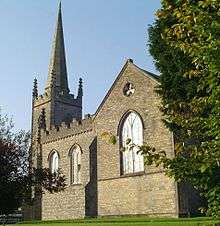
When Ireland was incorporated in 1801 into the new United Kingdom of Great Britain and Ireland, the Church of Ireland was also united with the Church of England to form the United Church of England and Ireland. At the same time, one archbishop and three bishops from Ireland (selected by rotation) were given seats in the House of Lords at Westminster, joining the two archbishops and twenty-four bishops from the Church of England.
In 1833, the British Government introduced the Irish Church Temporalities Bill which proposed the administrative and financial restructuring of the church. The bill sought to reduce the number of both bishoprics and archbishoprics from 22 to 12, to change the structure of the leases of church lands and to apply the revenues saved by these changes for the use of parishes. The bill, not only had implications for the future political trajectory of the Whigs and Tories but also sparked the generation of the Oxford Movement, which was to have wide repercussions for the Anglican Communion.
As the official established church, the Church of Ireland was funded partially by tithes imposed on all Irish subjects of the Crown. Irrespective of the fact that the adherents of the church were never more than a small minority of the populace, the population at large was expected to pay for its upkeep. Following the defeat of Roman Catholic arms in 1691, no armed resistance was to be expected to this discriminatory policy. Nevertheless, peasant resentment of the tithes occasionally boiled over, as in the "Tithe War" of 1831–36. Eventually, the tithes were ended, replaced with a lower levy called the tithe rentcharge. The last remnant of the tithes was not abolished until disestablishment in 1871.
The Irish Church Act 1869 (which took effect on 1 January 1871) finally ended the role of the Church of Ireland as state church. This terminated both state support and parliament's role in its governance, but also took into government ownership much church property. At the establishment of the state church, no compensation had been given to Roman Catholic clergy who suffered loss in the seizure of church property by the state; at its disestablishment, compensation was provided to clergy by the state.[18] On both occasions, parishes faced great difficulty in local financing after the loss of rent-generating lands and buildings. The Church of Ireland made provision in 1870 for its own government, led by a General Synod, and with financial management by a Representative Church Body. With disestablishment, the church's representation in the House of Lords also ceased.
Like other Irish churches, the Church of Ireland did not divide when Ireland was partitioned in the 1920s. It continues to be governed on an all-Ireland basis.
Present

The Churches of the Anglican Communion are linked by affection and common loyalty. They are in full communion with the See of Canterbury and thus the Archbishop of Canterbury, in his person, is a unique focus of Anglican unity. He calls the once-a-decade Lambeth Conference, chairs the meeting of Primates, and is President of the Anglican Consultative Council.[19] The contemporary Church of Ireland, despite having a number of High Church (often described as Anglo-Catholic) parishes, is generally on the Low Church end of the spectrum of world Anglicanism. Historically, it had little of the difference in organisation between parishes characteristic of other Anglican provinces, although a number of markedly liberal, High Church or Evangelical parishes have developed in recent decades. It was the second province of the Anglican Communion after the Anglican Church of New Zealand (1857) to adopt, on its 1871 disestablishment, synodical government. It was also one of the first provinces to begin ordaining women to the priesthood (1991).
The Church of Ireland has two cathedrals in Dublin: within the walls of the old city is Christ Church Cathedral, the seat of the Archbishop of Dublin, and just outside the old walls is St. Patrick's Cathedral, which the church designated as a National Cathedral for Ireland in 1870. Cathedrals also exist in the other dioceses. The church operates a seminary, the Church of Ireland Theological Institute, in Rathgar, in the south inner suburbs of Dublin. The church's central offices are in Rathmines, adjacent to the Church of Ireland College of Education, and the Church's library is in Churchtown.
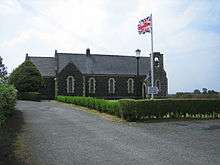
In 1999, the church voted to prohibit the flying of flags other than St Patrick's flag and the Flag of the Anglican Communion.[20] However, the Union Flag continues to fly on many churches in Northern Ireland.

Membership
The Church of Ireland experienced major decline during the 20th century, both in Northern Ireland, where around 65% of its members live, and in the Republic of Ireland which contains upwards of 35%. However, the Church of Ireland in the Republic has shown substantial growth in the last two national censuses; its membership is now back to the levels of sixty years ago (albeit with fewer churches as many have been closed). Church membership increased by 8.7% in the period 2002–2006, during which the population as a whole increased by only 8.2%.[21] Various reasons for this increase have been proposed. One is the relaxation of the Ne Temere regulations originally issued in 1907 and taking effect in 1908 that stipulated that children of mixed Roman Catholic – Protestant marriages should be brought up as Roman Catholics. It is also partly explained by the number of Anglican immigrants who have moved to Ireland recently (mostly from Great Britain and former British colonies).[22][23][24]
Ordination of Women
On women's issues, the church has ordained women to all offices. In 1990, the church began ordaining women to the priesthood,[25] and, in 2013, appointed its first woman bishop.[26]
Same-sex unions and LGBT clergy
The church has been divided over human sexuality. In 2002, the issue became pertinent as a vicar provided a blessing for a lesbian couple.[27] The denomination announced a period of discernment to allocate time to the perspectives within the discussion. In 2010, a congregation was recognised by the church for receiving an LGBTI award for offering services for LGBTI people.[28]
Civil partnerships have been allowed since 2005. The church has no formal position on such relationships, and in 2011, a cleric in the Church of Ireland entered into a same-sex civil union which was welcomed by his congregation.[29] In 2012, the church's Clergy Pension Fund recognised that "the pension entitlement of a member’s registered civil partner will be the same as that of a surviving spouse."[30] The church recognises four general viewpoints within the denomination ranging from opposition to acceptance toward same-gender relationships.[31]
Prior to the referendum on same-sex marriage, the church remained neutral on the issue.[32] In 2015, the Bishop of Cork, the Rt. Rev. Paul Colton,[33] Bishop Michael Burrows of Cashel,[34] and two retired archbishops of Dublin endorsed same-sex marriage.[35] While voting "no" on gay marriage, Bishop Pat Storey endorsed civil unions.[36] Also, 55 clergy signed a letter supporting the blessing of same-sex couples.[37] In its pastoral letter, the church reiterated that, presently, church marriages are only for heterosexual couples, but that clergy may offer prayers for same-sex couples.[38] REFORM Ireland, a conservative lobby, has criticised the official letter and continues to oppose same-sex marriage recognition.[39] Reflecting division, the church deferred its report on same-sex marriage in order to listen to all voices.[40] The Church of Ireland Gazette, although "editorially independent", endorsed a blessing rite for same-sex couples.[41] Many congregations, including cathedrals, have become publicly affirming of LGBTI rights.[42] A church report has determined that "the moral logic underpinning the negative portrayal of same-sex eroticism in Scripture does not directly address committed, loving, consecrated same-sex relationships today".[43][44]
Structure

▉▉▉ Province of Armagh
▉▉▉ Province of Dublin
The polity of the Church of Ireland is episcopal church governance, as in other Anglican churches. The church maintains the traditional structure dating to pre-Reformation times, a system of geographical parishes organized into dioceses. There were more than 30 of these historically, grouped into four provinces; today, after consolidation over the centuries, there are 12 Church of Ireland dioceses, each headed by a bishop and belonging to one of the two surviving provinces. The leader of the southern province is the Archbishop of Dublin, at present Michael Jackson; that of the northern province is the Archbishop of Armagh, at present Richard Clarke. These two archbishops are styled Primate of Ireland and Primate of All Ireland respectively, suggesting the ultimate seniority of the latter. Although he has relatively little absolute authority, the Archbishop of Armagh is respected as the church's general leader and spokesman and is elected in a process different from those for all other bishops.
Canon law and church policy are decided by the church's General Synod and changes in policy must be passed by both the House of Bishops and the House of Representatives (clergy and laity). Certain important changes, for example the decision to ordain women as priests, must be passed by a majority of two-thirds of both houses. While the House of Representatives always votes publicly, often by orders, the House of Bishops has tended to vote in private, coming to a decision before matters reach the floor of the synod. This practice has been broken only once when, in 1999, the House of Bishops voted unanimously in public to endorse the efforts of the Archbishop of Armagh, the Diocese of Armagh and the Standing Committee of the General Synod in their attempts to resolve the crisis at the Church of the Ascension at Drumcree near Portadown.[45]
The Church of Ireland embraces three orders of ministry: deacons, priests (or presbyters) and bishops. These orders are distinct from positions such as rector, vicar or canon.
Ecumenical relations
Like many other Anglican churches, the Church of Ireland is a member of many ecumenical bodies, including the World Council of Churches, the Conference of European Churches, Churches Together in Britain and Ireland, and the Irish Council of Churches. It is also a member of the Porvoo Communion.
Doctrine and practice
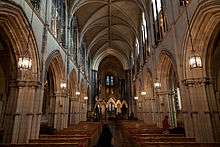
The centre of the Church of Ireland's teaching is the life, death and resurrection of Jesus Christ. The basic teachings of the church include:
- Chalcedonian Christology; Jesus Christ is fully human and fully God in one person. He died and was resurrected from the dead.
- Jesus provides the way of eternal life for those who believe.
- The Old and New Testaments of the Bible ("God's Word written") were written by people "under the inspiration of the Holy Spirit". The Apocrypha are additional books that are to be read, but not to determine doctrine. The Apocrypha of the King James version of the Bible constitutes the books of the Vulgate version that are present neither in the Hebrew Old Testament nor the Greek New Testament.
- The "two great and necessary" sacraments are Baptism and the Eucharist (also called Holy Communion and the Lord's Supper).
- Those "commonly called Sacraments that are not to be counted for Sacraments of the Gospel" are confirmation, ordination, marriage, reconciliation of a penitent and unction.
- Belief in heaven, hell and Jesus's return in glory.
The 16th century apologist, Richard Hooker, posits that there are three sources of authority in Anglicanism: scripture, tradition and reason. It is not known how widely accepted this idea is within Anglicanism. It is further posited that the three sources uphold and critique each other in a dynamic way. In Hooker's model, scripture is the primary means of arriving at doctrine; things stated plainly in scripture are accepted as true. Issues that are ambiguous are determined by tradition, which is checked by reason.[46]
Irish language
The first translation of the Book of Common Prayer into Irish was published in 1606. An Irish translation of the revised prayer book of 1662 was published in 1712.
The Church of Ireland has its own Irish language body, Cumann Gaelach na hEaglaise ("Irish Guild of the Church"). This was founded in 1914 to bring together members of the Church of Ireland interested in the Irish language and Gaelic culture and to promote the Irish language within the Church of Ireland. The guild aims to link its programmes with the Irish language initiatives which have been centred round Christ Church Cathedral. It holds services twice a month in Irish.[47]
From 1926 to 1995, the church had its own Irish-language teacher training college, Coláiste Moibhí. Today, there are a number of interdenominational Gaelscoileanna (schools where Irish-medium education is applied).
See also
- Anglo-Irish
- Bishops' Selection Conference
- Fellowship of Vocation
- Protestantism in Ireland
- Religion in Northern Ireland
- Religion in the Republic of Ireland
References
- ↑ "APCK Leaflet: An Ghaeilge agus Eaglais na hÉireann". Church of Ireland official website.
- ↑ 2001 Northern Irish census leaflet, Ulster-Scots NI Statistics and Research Agency. Retrieved 25 September 2012.
- ↑ Church of Ireland, Britannica.com
- ↑ "Membership figures". churchsociety.org. Church of England Yearbook 2004. Retrieved May 1, 2016.
- ↑ "About Us", Church of Ireland website
- ↑ Church of Ireland Archived April 2, 2015, at the Wayback Machine.
- ↑ Protestant and Catholic, APCK Study Leaflet, 1996
- ↑ Republic of Ireland Central Statistics Office, Census 2006: Principal Demographic Results.
- ↑ 2011 Census, Key Statistics for Northern Ireland, December 2012, p. 19.
- ↑ "What we believe" Church of Ireland official website.
- ↑ "Protestant and Catholic" Church of Ireland official website.
- ↑ "Preamble and Declaration of the Constitution of the Church of Ireland 1870, 1.3" Church of Ireland official website.
- ↑ Austin Lane Poole From Domesday book to Magna Carta, 1087-1216 Oxford University Press, 1993, pp303-304 (readable on Google books)
- ↑ Clarke, "Varieties of Uniformity", pg120.
- ↑ Creeds of Christendom, with a History and Critical notes. Volume I. The History of Creeds. | Christian Classics Ethereal Library
- ↑ "Treasures of the Irish Language: Some early examples from Dublin City Public Libraries". 2006. Archived from the original on 2012-03-09. Retrieved 2012-10-03.
- ↑ "Bedell's Irish Old Testament". King's College London. Retrieved 2012-10-03.
- ↑ Cross Denominational Mission "The Irish Church Disestablishment Act 1869 came into effect in 1871 and the Church of Ireland ceased to be the state church. This terminated both state support and parliamentary authority over its governance, and took into public ownership much church property. Compensation was provided to clergy, but many parishes faced great difficulty after the loss of rent-generating land, property and buildings."
- ↑ Anglican Communion Official Website.
- ↑ Flags of the World: St. Patrick's Flag as flag of Church of Ireland: "The General Synod of the Church of Ireland recognises that from time to time confusion and controversy have attended the flying of flags on church buildings or within the grounds of church buildings. This Synod therefore resolves that the only flags specifically authorised to be flown on church buildings or within the church grounds of the Church of Ireland are the cross of St Patrick or, alternatively, the flag of the Anglican Communion bearing the emblem of the Compassrose. Such flags are authorised to be flown only on Holy Days and during the Octaves of Christmas, Easter, the Ascension of Our Lord, Pentecost, and on any other such day as may be recognised locally as the Dedication Day of the particular church building. Any other flag flown at any other time is not specifically authorised by this Church...."
- ↑ Republic of Ireland Central Statistics Office, Census 2006: Principal Demographic Results.
- ↑ Macourt, Malcolm (2009). Counting the People of God?: The Census of Population and the Church of Ireland. Dublin: Church of Ireland Publishing. ISBN 1904884202.
- ↑ "Profile of the Church of Ireland/Anglican Communion". Intercultural Guide. HSE. Retrieved 3 June 2015.
- ↑ Markham et al (ed.), Ian (2013). The Wiley-Blackwell Companion to the Anglican Communion. John Wiley & Sons. pp. Chapter 39 – The Anglican Church in Ireland. ISBN 9781118320860.
- ↑ "Church of Ireland Ordains First Two Women Priests". Tulsa World. Retrieved 2016-05-14.
- ↑ Staff and agencies (2013-09-20). "Anglicans appoint first female bishop in UK and Ireland". the Guardian. Retrieved 2016-05-14.
- ↑ Tierney, Ciaran. "Lesbian couple get church blessing.(News)". highbeam.com. The Mirror. Retrieved January 11, 2016.
- ↑ Synod), Central Communications Board of the General. "Church of Ireland - A Member of the Anglican Communion". ireland.anglican.org. Retrieved 2016-04-30.
- ↑ "Minister Rev Tom Gordon civil partnership 'welcomed'". bbc.com. BBC. Retrieved January 11, 2016.
- ↑ "Church of Ireland: Clergy Pensions Fund Explanatory Booklet" (PDF). ireland.anglican.org. Church of Ireland. April 2012. Retrieved October 30, 2016.
- ↑ Synod), Central Communications Board of the General. "Church of Ireland - A Member of the Anglican Communion". ireland.anglican.org. Retrieved 2016-05-15.
- ↑ Ryan, Órla. "Church of Ireland won't be campaigning for same-sex marriage vote". TheJournal.ie. Retrieved 2016-04-23.
- ↑ "Same-sex marriage backed by Church of Ireland bishop - BBC News". BBC News. Retrieved 2016-04-12.
- ↑ "Gay row could 'cause Church of Ireland schism'". www.newsletter.co.uk. Retrieved 2016-04-12.
- ↑ "Archbishops and leading theologian call for Yes vote". The Irish Times. Retrieved 2016-04-23.
- ↑ "Ireland set to approve gay marriage in public vote". 10NEWS. Retrieved 2016-04-12.
- ↑ "Letter from Church of Ireland clergy in support of TEC following Primates gathering". episcopalcafe.com. Episcopal Cafe. Retrieved February 1, 2016.
- ↑ "House of Bishops in the Church of Ireland develop a pastoral letter regarding same gender marriage in the Republic". Episcopal Cafe. Retrieved 2016-04-12.
- ↑ "Reform Ireland takes their bishops to task over their gay marriage pastoral letter | Anglican Ink 2016 ©". www.anglican.ink. Retrieved 2016-05-02.
- ↑ "Same-sex marriage: Church of Ireland defers report on 'elephant in the room' - BelfastTelegraph.co.uk". BelfastTelegraph.co.uk. Retrieved 2016-04-12.
- ↑ "Church of Ireland Gazette calls for blessings for same-sex marriages". newsletter.co.uk. Newsletter UK. Retrieved April 17, 2016.
- ↑ "Other Churches supportive of LGBT Christians". changingattitudeireland.org. Changing Attitude Ireland. Retrieved April 18, 2016.
- ↑ "Church of Ireland challenged by report on homosexuality | Christian News on Christian Today". www.christiantoday.com. Retrieved 2016-05-14.
- ↑ "Guide to the Conversation on Human Sexuality in the Context of Christian Belief" (PDF). ireland.anglican.org. General Synod of the Church of Ireland. 2016. Retrieved May 14, 2016.
- ↑ Sectarianism Report Motions. Ireland.anglican.org. Retrieved on 2013-07-23.
- ↑ Anglican Listening Detail on how scripture, tradition and reason work to "uphold and critique each other in a dynamic way".
- ↑ Church of Ireland Notes, page 2, Irish Times, 10 January 2009
- General
- Flanagan, Marie Therese (2005), "High-kings with opposition, 1072-1166", in Ó Cróinín, Dáibhí, Prehistoric and Early Ireland, A New History of Ireland, I, Oxford: Oxford University Press, pp. 899–933, ISBN 978-0-19-922665-8
Further reading
- Cross, F. L. (ed.) (1957) The Oxford Dictionary of the Christian Church. Oxford: U. P.; pp. 700–701
- Neill, Stephen (1965) Anglicanism. Harmondsworth: Penguin Books
- MacCarthy, Robert Ancient and Modern: a short history of the Church of Ireland. Four Courts Press Ltd., 1995
- The Church of Ireland: An illustrated history Booklink. 2013 ISBN 1906886563
External links
- Church of Ireland
- Church of Ireland Theological Institute
- Representative Church Body Library
- Irish Articles of 1615.


